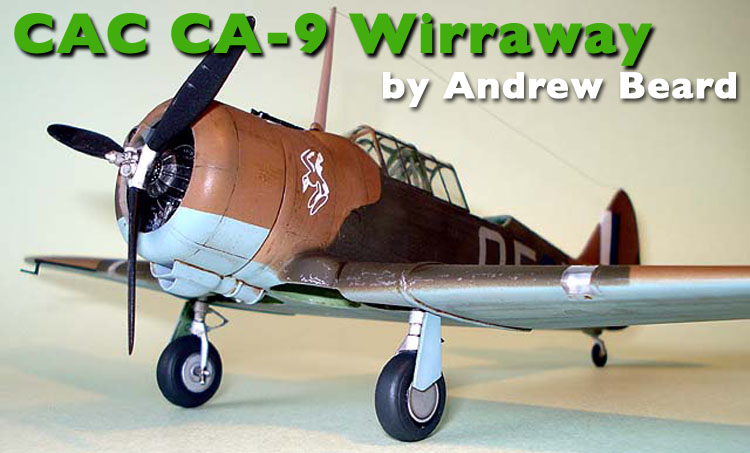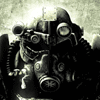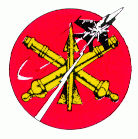1⁄48CAC C-9 Wirraway
7
Comments
Introduction
Even though I usually don't model Australian subjects, the Wirraway is one of those sorts of aircraft that appeals to me. I prefer early war aircraft or aircraft that were maligned or outclassed but served when there was nothing else at the time. And the Wirraway is one of those aircraft. So I was glad to see Special Hobby kit it.A good in box review has already been done by Merlin (see here). What follows is some build notes and futher comments on the kit that could be helpful to people that want to build one.
Construction
One of the first things I did was clean up all the resin and assemble the cowling halves... often resin engines simply don't fit inside because they are scaled to the correct size of the original and don't take into acount the thickness of the plastic cowls. But this one fitted perfect.The cockpit is fiddly, but I think represents the steel tube structure very well. One thing about the plastic SH use, it is very soft and flexible which sometimes has benefits and sometimes is a hindrance.
The cockpit assembly fitted perfectly inside the fuselage sides. But a test fit of the canopy later found that the roll over framing was WAY too high. So I had to pull that off trim about 3mm from each leg and re-fit. Otherwise the cockpit went together well.
One area that I was a bit scared of was the forward wing to fuselage join. It was a combination join of the interior cockpit floor, lower wing, and fuselage halves. All this in a limited run kit didn't sound like a good idea. However it wasn't as bad as expected...the soft flexible plastic sort of helps a bit when adjusting this area. It wasn't filler free, but not too bad either.
The area where test fitting did show a problem was the top wing to body join. If done the usual way, joining all the wing halves and then fitting to the fuselage, it seemed that a step and gap would result along the critical upper wing to body join. And we all know that is a very hard place to fill and blend, especially with a step involved. So I did it this way: First I joined the lower wing to fuselage to get that above mentioned lower front wing to fuselage join acceptable. Then I superglued the top wings only along the upper wing to body join, leaving the rest of the top wings loose for now. Then I taped and glued the remainder of the wing tops using liquid cement. This made a filler less join along the top wing to fuselage join. It did mean that some filler was needed at the leading edges of the wing roots, but I felt that was far easier to fix than a step all along the top wing root to fuselage. In the pic you can also see that I used some sprue to spread the upper forward fuselage sides slightly, as they tended to pinch in at the top.
The landing lights didn't fit well. I expected that...well it's common even with regular high production kits, so it has to be expected for limited run kits. I coated the clear landing light covers in Tamiya Clear X-13 to prevent fogging inside and super glued them. Then I filed and sanded and finished with micromesh. It only took 15 minutes all up.
Normally I paint the cowl seperately and fit it later for radial engined subjects. But in this case it cannot be done because the lower air scoop is fitted to both the lower fuselage and the cowl. And test fitting showed it would need some filler, so it couldn't be fitted after painting.
The canopy is very thin and clear. But it is also very brittle and easy to get tiny hairline cracks. Also the way it is attached to the sprue at the very front makes it extremely difficult to remove without damage. Despite all the care I could apply I still ended up with a some damage to the front of the canopy...luckily it was just framework and could be filled after fitting.
Painting and Markings
There's some that argue about the Green used by RAAF aircraft. Some think it's quite dark and others think it was more vivid and lighter. I think in the conditions they operated in it could probably result in a very wide range of shades over the operational life of the aircraft. Just mix a colour you like and go with it, she'll be right! I used Tamiya Dark Green with a bit of Gunze Sail Colour mixed for shading. I think the earth brown was a bit more reddish than the RAF version. So mine is a mix of Gunze Flat Earth and Tamiya Red Brown- that's esentially what SH call for in their markings chart as well. The Camouflage schemes are clearly marked out in colour in SH's instructions, both sides of the aircraft being shown. The Sky Blue was a mix of Gunze and Tamiya colours that I now can't remember. The RAAF blue was quite vivid.The decals were very well printed and thing. They settled perfectly. The only thing to watch for is that they tend to grab onto the surface very fast and then resist any further movement. I found it best not to use a setting solution under the decals for that reason. Just use water and finish with a softening solution.
Conclusion
I'm happy with the end result, though I forgot to tighten the antenna wire before taking the pics!This is the second Special Hobby kit that I've made and I believe represents excellent value for the money. The way that SH do their surface detail (like fabric over structure) closer to scale than almost anyone else gets them high marks from me. And somehow SH seem to get these kits onto my LHS shelves still at a very good price when compared to other Czech companies.
The only negative comment on the Wirraway kit is the lack of underwing stores. As this kit represents the trainer aircraft that were pressed into close support duties, some underwing bomb racks and bomms would have been nice. Maybe a gun for the rear position could have been supplied but, to my knowledge, these trainers flew close support without a rear crew member. So I'd assume no rear gun would be carried.
Of course the parts breakdown indicates that more versions could be released. Possibly the strengthened dive bomber version maybe?
Comments
Well done! mine is on the bench for early 2009! Nevertheless there are a couple of points I would like to point out/ the color of the interior should be silver dope and not grey green, then the tail wheel is undersized and the tubular structure of the cockpit is of the wrong pattern. Do not beleive I am a specialist of that plane, but have a look at that: file:///Users/jean/Desktop/Review%20-%20SH48054%20CAC%20CA-9%20Wirraway%20review%20by%20David%20Harvey.webarchive and let me know what you think. In the meantime have a great new year, best regards, jean.
DEC 31, 2008 - 06:55 AM
Hi Jean!
Very interesting link. The informations are on my HD now. Thanks for sharing...
By the way... Bonne Année 2009!
Jean-Luc
JAN 01, 2009 - 07:49 AM
Same to you jean-luc, hope to meet you in person this year. Bye for now, jean.
JAN 02, 2009 - 05:58 AM
Copyright ©2021 by Andrew Beard. Images also by copyright holder unless otherwise noted. The views and opinions expressed herein are solely the views and opinions of the authors and/or contributors to this Web site and do not necessarily represent the views and/or opinions of AeroScale, KitMaker Network, or Silver Star Enterrpises. Images also by copyright holder unless otherwise noted. Opinions expressed are those of the author(s) and not necessarily those of AeroScale. All rights reserved. Originally published on: 2008-12-28 00:00:00. Unique Reads: 9542































